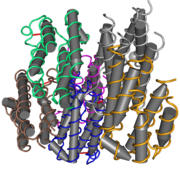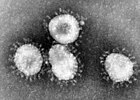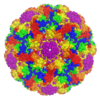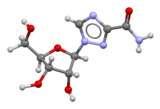Portal:Viruses
The Viruses Portal
Welcome!

Viruses are small infectious agents that can replicate only inside the living cells of an organism. Viruses infect all forms of life, including animals, plants, fungi, bacteria and archaea. They are found in almost every ecosystem on Earth and are the most abundant type of biological entity, with millions of different types, although only about 6,000 viruses have been described in detail. Some viruses cause disease in humans, and others are responsible for economically important diseases of livestock and crops.
Virus particles (known as virions) consist of genetic material, which can be either DNA or RNA, wrapped in a protein coat called the capsid; some viruses also have an outer lipid envelope. The capsid can take simple helical or icosahedral forms, or more complex structures. The average virus is about 1/100 the size of the average bacterium, and most are too small to be seen directly with an optical microscope.
The origins of viruses are unclear: some may have evolved from plasmids, others from bacteria. Viruses are sometimes considered to be a life form, because they carry genetic material, reproduce and evolve through natural selection. However they lack key characteristics (such as cell structure) that are generally considered necessary to count as life. Because they possess some but not all such qualities, viruses have been described as "organisms at the edge of life".
Selected disease
Smallpox is an eradicated infectious disease of humans caused by the Variola major and V. minor viruses. V. major causes a serious disease with a mortality rate of around 30%; V. minor is associated with much milder symptoms and mortality below 1%. The virus is mainly transmitted by the respiratory route but can also be carried on contaminated objects. Smallpox preferentially infects skin cells, resulting in a usually maculopapular rash, and later, raised fluid-filled blisters. Most V. major survivors have permanent scarring, commonly on the face, which can be extensive. Less common long-term complications include blindness resulting from corneal ulceration and scarring, and in young children, limb deformities due to arthritis and osteomyelitis.
Smallpox probably emerged in human populations in about 10,000 BC; the mummified body of Egyptian pharaoh Ramses V shows evidence of smallpox rash. The disease was responsible for an estimated 300–500 million deaths during the 20th century. Smallpox vaccine, the earliest vaccine, was developed in the 18th century. After intensive vaccination campaigns, the last natural infection occurred in 1977. Smallpox was certified the first infectious disease to be eradicated globally in 1979. Debate is ongoing over whether all stocks of the virus should be destroyed.
Selected image
Tobacco mosaic virus was the first virus to be identified, as an infectious agent that could pass through porcelain filters, as well as the first to be crystallised. It was among the earliest virus structures to be modelled successfully.
Credit: Thomas Splettstoesser (20 July 2012)
In the news
26 February: In the ongoing pandemic of severe acute respiratory syndrome coronavirus 2 (SARS-CoV-2), more than 110 million confirmed cases, including 2.5 million deaths, have been documented globally since the outbreak began in December 2019. WHO
18 February: Seven asymptomatic cases of avian influenza A subtype H5N8, the first documented H5N8 cases in humans, are reported in Astrakhan Oblast, Russia, after more than 100,0000 hens died on a poultry farm in December. WHO
14 February: Seven cases of Ebola virus disease are reported in Gouécké, south-east Guinea. WHO
7 February: A case of Ebola virus disease is detected in North Kivu Province of the Democratic Republic of the Congo. WHO
4 February: An outbreak of Rift Valley fever is ongoing in Kenya, with 32 human cases, including 11 deaths, since the outbreak started in November. WHO
21 November: The US Food and Drug Administration (FDA) gives emergency-use authorisation to casirivimab/imdevimab, a combination monoclonal antibody (mAb) therapy for non-hospitalised people twelve years and over with mild-to-moderate COVID-19, after granting emergency-use authorisation to the single mAb bamlanivimab earlier in the month. FDA 1, 2
18 November: The outbreak of Ebola virus disease in Équateur Province, Democratic Republic of the Congo, which started in June, has been declared over; a total of 130 cases were recorded, with 55 deaths. UN
Selected article
Interferons are a group of signalling proteins released by host cells in response to viruses and other pathogens. They belong to a large class of proteins known as cytokines: molecules used for communication between cells to trigger the protective defences of the immune system that help to eradicate pathogens. More than twenty distinct interferon genes and proteins have been identified in animals, including humans.
When a cell is infected by a virus, several virus products, including glycoproteins and viral RNA, stimulate the cell to produce and release interferons. This causes nearby cells to heighten their defences against viral infection, and so interferes with viral replication. Some viruses, including Japanese encephalitis virus, dengue type 2 virus, human cytomegalovirus and Kaposi's sarcoma-associated herpesvirus, have evolved ways to resist interferon's antiviral activity. Interferons also have various other functions in regulating the immune system. Interferons and other cytokines are responsible for some symptoms of infection, such as fever, muscle pain and "flu-like symptoms".
Selected outbreak
In the severe acute respiratory syndrome (SARS) outbreak, the first cases of the newly emerged SARS coronavirus were reported in November 2002 from the Chinese Guangdong province. The virus soon spread across Asia, with China, Hong Kong, Taiwan and Singapore being the worst affected countries; a secondary outbreak occurred in Canada. The rapid initial spread of the outbreak has been in part attributed to China's slow response to the early cases. Over 8,000 people were infected, with a case fatality rate of 11%. Those over 65 years had a much higher mortality rate, greater than 55%. The outbreak was contained by July 2003, and no cases have been reported since 2004.
At the time of the outbreak, the immediate source of SARS coronavirus was thought to have been the masked palm civet (Paguma larvata; pictured), which was sold as food in Guangdong markets. The virus was also found in raccoon dogs, ferret badgers and domestic cats. More recent research has suggested that the natural reservoir could be horseshoe bats.
Selected quotation
| “ | An inefficient virus kills its host. A clever virus stays with it. | ” |
Recommended articles
Viruses & Subviral agents: bat virome • elephant endotheliotropic herpesvirus • HIV • introduction to viruses![]() • Playa de Oro virus • poliovirus • prion • rotavirus
• Playa de Oro virus • poliovirus • prion • rotavirus![]() • virus
• virus![]()
Diseases: colony collapse disorder • common cold • croup • dengue fever![]() • gastroenteritis • Guillain–Barré syndrome • hepatitis B • hepatitis C • hepatitis E • herpes simplex • HIV/AIDS • influenza
• gastroenteritis • Guillain–Barré syndrome • hepatitis B • hepatitis C • hepatitis E • herpes simplex • HIV/AIDS • influenza![]() • meningitis
• meningitis![]() • myxomatosis • polio
• myxomatosis • polio![]() • pneumonia • shingles • smallpox
• pneumonia • shingles • smallpox
Epidemiology & Interventions: 2007 Bernard Matthews H5N1 outbreak • Coalition for Epidemic Preparedness Innovations • Disease X • 2009 flu pandemic • HIV/AIDS in Malawi • polio vaccine • Spanish flu • West African Ebola virus epidemic
Virus–Host interactions: antibody • host • immune system![]() • parasitism • RNA interference
• parasitism • RNA interference![]()
Methodology: metagenomics
Social & Media: And the Band Played On • Contagion • "Flu Season" • Frank's Cock![]() • Race Against Time: Searching for Hope in AIDS-Ravaged Africa
• Race Against Time: Searching for Hope in AIDS-Ravaged Africa![]() • social history of viruses
• social history of viruses![]() • "Steve Burdick" • "The Time Is Now" • "What Lies Below"
• "Steve Burdick" • "The Time Is Now" • "What Lies Below"
People: Brownie Mary • Macfarlane Burnet![]() • Bobbi Campbell • Aniru Conteh • people with hepatitis C
• Bobbi Campbell • Aniru Conteh • people with hepatitis C![]() • HIV-positive people
• HIV-positive people![]() • Bette Korber • Henrietta Lacks • Linda Laubenstein • Barbara McClintock
• Bette Korber • Henrietta Lacks • Linda Laubenstein • Barbara McClintock![]() • poliomyelitis survivors
• poliomyelitis survivors![]() • Joseph Sonnabend • Eli Todd • Ryan White
• Joseph Sonnabend • Eli Todd • Ryan White![]()
Selected virus
Coronaviruses are a subfamily of RNA viruses in the Nidovirales order which infect mammals and birds. They are spherical enveloped viruses, generally around 80–120 nm in diameter, containing a helical nucleocapsid. Their positive-sense single-stranded RNA genome ranges from approximately 26 to 32 kb in size, one of the largest among RNA viruses. Around 74 characteristic club-shaped spikes project from the envelope, which in electron micrographs resemble the solar corona, from which their name derives. Infectious bronchitis virus was isolated in 1933 from chickens; two mice coronaviruses causing hepatitis and encephalomyelitis were discovered in the 1940s.
Coronaviruses predominantly infect epithelial cells, with the viral spike protein determining tissue tropism and host range. Animal coronaviruses often infect the gastrointestinal tract, causing diarrhoea in cows and pigs, and are transmitted by the faecal–oral route. Human and bird coronaviruses infect the respiratory tract, are transmitted via aerosols and droplets; they cause respiratory tract infections that can range from mild to lethal. Mild illnesses in humans include around 15% of common cold cases, while more lethal coronaviruses cause SARS, MERS and COVID-19. Many human coronaviruses have evolved from viruses of bats.
Did you know?
- ...that murine polyomavirus (pictured) is an oncovirus that causes tumours in newborn mice?
- ...that Pat Nuttall showed that systemic infection of the host is not required for pathogens such as tick-borne encephalitis virus to be transmitted between vectors?
- ...that the first person to die in Australia from the 2009 flu was a Pintupi man whose people gave up hunting to settle the remote community of Kiwirrkura at the time of his birth?
- ...that the 2011 film Asmaa is the first feature-length Egyptian drama film to present AIDS patients sympathetically?
- ...that the anti-vaccine book Melanie's Marvelous Measles has received over 1,000 one-star reviews on Amazon.com?
Selected biography
Walter Reed (13 September 1851 – 22 November 1902) was an American physician in the U.S. Army medical corps who is known for his research on the epidemiology of yellow fever, at a time when viruses had only just been discovered.
Reed started to study yellow fever in the USA in the 1890s, showing that walking through swampy woods at night was associated with the disease, while drinking water from the Potomac River was not. In 1900, he led an army commission under the direction of George Miller Sternberg to investigate yellow fever in Cuba, where the disease was endemic. Building on Carlos Finlay's work suggesting that yellow fever was transmitted by a particular species of mosquito acting as a vector, Reed and co-workers confirmed Finlay's results, and also disproved the popular idea that the disease was transmitted by contaminated objects, such as clothing or bedding. The experiments involved the deliberate infection of human volunteers, several of whom died of yellow fever, and Reed pioneered the concept of medical consent.
In this month
May 1955: First issue of Virology; first English-language journal dedicated to virology
4 May 1984: HTLV-III, later HIV, identified as the cause of AIDS by Robert Gallo and coworkers
5 May 1939: First electron micrographs of tobacco mosaic virus taken by Helmut Ruska and coworkers
5 May 1983: Structure of influenza neuraminidase solved by Jose Varghese, Graeme Laver and Peter Colman
8 May 1980: WHO announced formally the global eradication of smallpox
11 May 1978: SV40 sequenced by Walter Fiers and coworkers
12 May 1972: Gene for bacteriophage MS2 coat protein is sequenced by Walter Fiers and coworkers, the first gene to be completely sequenced
13 May 2011: Boceprevir approved for the treatment of chronic hepatitis C virus (HCV) infection, the first direct-acting antiviral for HCV
14 May 1796: Edward Jenner inoculated James Phipps (pictured) with cowpox
15/16 May 1969: Death of Robert Rayford, the earliest confirmed case of AIDS outside Africa
18 May 1998: First World AIDS Vaccine Day
20 May 1983: Isolation of the retrovirus LAV, later HIV, by Luc Montagnier, Françoise Barré-Sinoussi and coworkers
23 May 2011: Telaprevir approved for the treatment of chronic HCV infection
25 May 2011: WHO declared rinderpest eradicated
31 May 1937: First results in humans from the 17D vaccine for yellow fever published by Max Theiler and Hugh H. Smith
Selected intervention
Ribavirin is a nucleoside analogue that mimics the nucleoside guanosine. It shows some activity against a broad range of DNA and RNA viruses, but is less effective against dengue fever, yellow fever and other flaviviruses. The drug was first synthesised in the early 1970s by Joseph T. Witkowski and Roland K. Robins. Ribavirin's main current use is against hepatitis C, in combination with pegylated interferon, nucleotide analogues and protease inhibitors. It has been used in the past in an aerosol formulation against respiratory syncytial virus-related diseases in children. Ribavirin has been used in combination as part of an experimental treatment for rabies. It is also the only available treatment for the viruses causing some viral haemorrhagic fevers, including Lassa fever, Crimean–Congo haemorrhagic fever and hantavirus disease, but is ineffective against the filovirus diseases, Ebola and Marburg. Clinical use is limited by the drug building up in red blood cells to cause haemolytic anaemia.
Subcategories
Subcategories of virology:
Topics
Things to do
- Comment on what you like and dislike about this portal
- Join the Viruses WikiProject
- Tag articles on viruses and virology with the project banner by adding {{WikiProject Viruses}} to the talk page
- Assess unassessed articles against the project standards
- Create requested pages: red-linked viruses | red-linked virus genera
- Expand a virus stub into a full article, adding images, citations, references and taxoboxes, following the project guidelines
- Create a new article (or expand an old one 5-fold) and nominate it for the main page Did You Know? section
- Improve a B-class article and nominate it for Good Article
 or Featured Article
or Featured Article status
status - Suggest articles, pictures, interesting facts, events and news to be featured here on the portal
WikiProjects & Portals
 WikiProject Viruses
Related WikiProjects
WikiProject Viruses
Related WikiProjects
Medicine • Microbiology • Molecular & Cellular Biology • Veterinary Medicine
Related PortalsAssociated Wikimedia
The following Wikimedia Foundation sister projects provide more on this subject:
-
Commons
Free media repository -
Wikibooks
Free textbooks and manuals -
Wikidata
Free knowledge base -
Wikinews
Free-content news -
Wikiquote
Collection of quotations -
Wikisource
Free-content library -
Wikispecies
Directory of species -
Wikiversity
Free learning tools -
Wiktionary
Dictionary and thesaurus



















